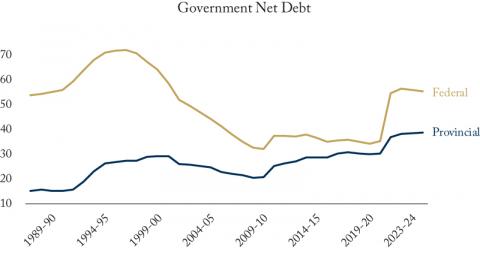From: Louis Lévesque
To: Canadians concerned about debt
Date: June 28, 2021
Re: Provincial Debt Levels (I): Historic Heights Pre-pandemic
The success story of the Canadian federal fiscal consolidation in the 1990s is well known. Less known is the fact that provincial debt levels followed a largely similar pattern, albeit at lower levels, until 2008. What is even less known is that the paths of provincial and federal debt levels radically diverged after the financial crisis of 2008.
As Figure 1 demonstrates, automatic stabilizers and the federal macroeconomic response plan implemented in 2009 resulted in a temporary upward tick to the federal debt as a percentage of GDP, but the downward trend resumed soon after. The decision by the new federal government elected in 2015 not to pursue the objective of balancing the budget explains why the rate of decline slowed between 2016 and 2019.
Figure 1 starkly illustrates that provincial debt levels have been on a completely different path, on a single and consistent upward direction since 2007. As result, provincial debt levels had already reached historically high levels at the end of 2019 prior to the pandemic, in fact closing in on the federal debt level. This situation, which has no precedent since 1945, suggests that provincial debt was already on an unsustainable path prior to the pandemic.
Rapid growth in provincial territorial health expenditures has been the largest factor pushing provincial debt levels upwards. Since 2007, growth in health care expenditures has consistently outpaced growth in total provincial revenues, inclusive of federal transfers. Canadian Institute for Health Information and fiscal reference tables data show this resulted in recurrent and growing annual pressures of over $30 billion by 2019, which had to be funded through reduced expenditures on other programs, lower debt charges or deficit spending.
Two other factors have also contributed to the growth in provincial debt. First, lower oil prices since 2014 played a major role in the runaway growth of debt in the two provinces most dependent on oil revenues, Newfoundland and Labrador and Alberta. The federal stabilization program provided only minimal offset to the revenue shock, and the actions needed to address chronic overspending in Newfoundland and Labrador and deficient tax effort in Alberta are largely yet to come. That said, given the net asset position of Alberta at the time of the shock and its much stronger economy, its fiscal situation is far less difficult than that of Newfoundland and Labrador.
Second, the important reinvestment in public infrastructure that started after 2000 following years of neglect is another less understood factor pushing provincial debt levels upward. Infrastructure spending was facilitated by the general adoption of accrual accounting, under which capital spending can be made without immediate impacts on the budgetary balance. However, examination of provincial budgets and end-of-year financial statements reveal that a significant portion of infrastructure reinvestment has ended up being debt financed and has thus contributed to the rise in provincial debt levels.
This divergence in the debt dynamics between the federal government and provinces after 2007 has occurred largely without being noticed. It is possible that federal debt will get back to a downward track once pandemic spending stops as happened after the financial crisis. However, and with the exception of the oil-price rebound, there is no reason to expect that pressures on provincial debt associated with healthcare spending and infrastructure will subside anytime soon. In addition, the pandemic fiscal shock and its aftermath will only serve to push provincial debt levels higher.
These were the trends up to the round of federal provincial budgets released in spring of 2021. Tomorrow, we will explore what the future looks like.
Louis Lévesque is a former federal deputy minister whose focus for many years was fiscal federalism.
To send a comment or leave feedback, email us at blog@cdhowe.org.
The views expressed here are those of the author. The C.D. Howe Institute does not take corporate positions on policy matters.
Source: Fiscal reference tables, federal and provincial 2021 budgets






